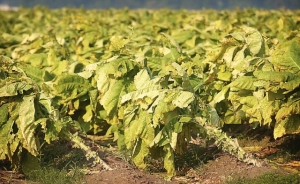Irene could cost half of this year's tobacco crop
By Steve Herring
Published in News on August 29, 2011 1:46 PM

News-Argus/MICHAEL K. DAKOTA
Tobacco plants whipped by the high winds of Hurricane Irene lie toppled over in a field off Hood Swamp Road. Agricultural officials say as much as half of Wayne County's tobacco crop could be a loss.
Hurricane Irene may have cost Wayne County tobacco farmers more than half of their crop. Initial estimates put the loss at $16 million.
Tobacco remains the chief cash field crop in Wayne and most other eastern North Carolina counties.
High winds knocked over entire fields, making the harvesting of the leaves difficult, if not impossible.
"The situation with tobacco farmers is not good -- that is our biggest agriculture problem," Wayne County Extension Director Kevin Johnson said. "The plants are lying on the ground. There is not enough labor in the United States to set up all of the tobacco in eastern North Carolina. It is a grave situation that our agriculture community is in right now. Farmers don't know what to do and are looking for alternatives."
The damage from Irene isn't limited to the tobacco fields. Other field crops were damaged, along with livestock buildings and infrastructure.
State political and agricultural leaders touring eastern North Carolina on Sunday said they saw widespread damage. Gov. Beverly Perdue flew around the region, getting a firsthand look.
"It's just been hard for agriculture," the governor said at a media briefing in Kill Devil Hills.
Johnson estimated that at least 85 percent of the tobacco plants on the county's 9,700 acres are either on the ground or leaning at a 30 degree angle or more. There are no machines to straighten the plants -- it has to be done by hand.
"Those right on the ground will take a lot of time and then farmers must worry about the integrity of the plants and their roots and there is no guarantee they will remain up once they have been set up," he said.
The wind did more than blow the plants down. It left them bruised. That bruising causes the plants to produce a chemical that speeds up the ripening process, meaning that farmers won't have as much time to harvest the crop.
"We have probably lost half of the crop, and we expect that to increase," Johnson said.
Some farmers have insurance. However, in some cases the insurance policy requires that farmers try to set the stalks back up, he said.
Less than a quarter of the tobacco crop has been harvested, Johnson said. Normally harvesting continues through October. This year, the harvest is later than normal because of the drought that kept the leaves from maturing. However, rain just prior to Irene had helped leaves begin maturing.
Johnson said he knows of one farmer who has five workers on his 120 acres of tobacco. It would take him a week to set up just 20 acres, Johnson said.
"There is no way they get all of this in," he said.
Complicating the issue further is how the tobacco companies will respond -- will they want the damaged crop or not, he said.
The county's corn crop that already had been devastated by drought was not badly damaged by the wind, Johnson said. Cotton and soybeans also escaped major damage as well.
Many farm buildings suffered damage, particularly to roofs.
State officials said it could be several days before they can come up with a total damage estimate.
The top leaders at the General Assembly -- House Speaker Thom Tillis and Senate leader Phil Berger -- joined fellow Republican Agriculture Commissioner Steve Troxler on a separate aerial tour focused on agriculture.
Farmers could receive low-interest loans from the federal government if an agricultural disaster is declared in the state.
-- The Associated Press contributed to this report.
